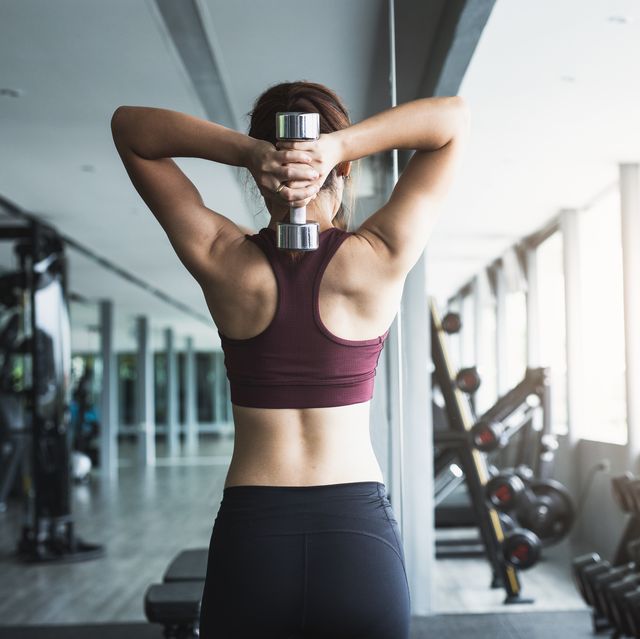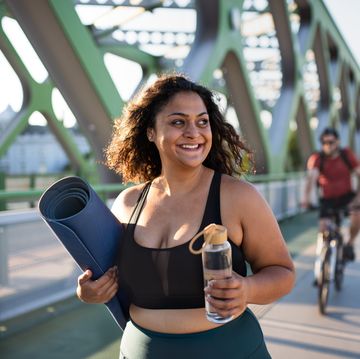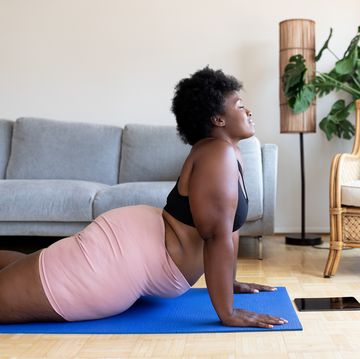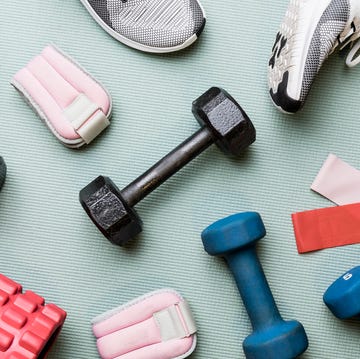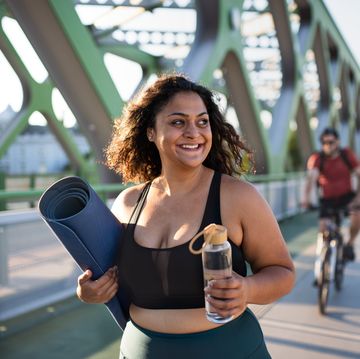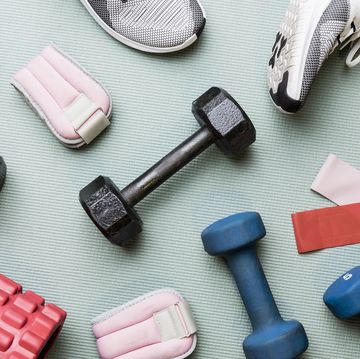Everyone has different goals for their fitness, and getting more definition in your arms is both a hot topic and admittedly quite tricky...which can lead you down an internet rabbit hole of trying to figure out how to lose arm fat, specifically. That’s probably how you ended up here on this page!
Genetic makeup and disposition decide how much fat you have and where you store it. Men tend to store fat in their stomach, while women often store fat in several places, including on their arms. And to be clear, experts agree that losing weight in just one area of your body is impossible...and that a thoughtful, full-body approach, backed by science, is the most helpful path should it be something you desire.
Meet the experts: Shana Maleeff, M.A., R.D.; Caroline Grainger, ISSA certified personal trainer at FitnessTrainer Online Personal Trainers; Megan Johnson McCullough, Ed.D, certified fitness trainer; Ramona Braganza, celebrity fitness trainer; Daniel Saltos, certified personal trainer and founder of Train with Danny; Jessica Cording, M.S., R.D., author of The Little Book of Game-Changers: 50 Healthy Habits For Managing Stress & Anxiety; Keri Gans, R.D., author of The Small Change Diet.
Arm fat has also been linked with a greater risk of developing metabolic syndrome, which is a group of conditions that raise your risk of coronary heart disease and stroke. Of course, everyone is different, and some people just naturally have more arm fat than others.
Why do you develop arm fat?
Since women tend to have lower testosterone levels than men, building muscle can be a more extensive process. “Couple this with stress, poor diet, lack of sleep, weight fluctuations due to pregnancies and/or menopause, and genetics—these things are a recipe for fat to make a home in the arms,” says Megan Johnson McCullough, Ed.D, certified fitness trainer.
There’s a strong hormonal component to fat deposits, which is why more women may experience arm fat. “Your biological sexual characteristics will have a lot to say about where your body stores its fat, and the arms are one area where fat is more common in women than in men,” says Caroline Grainger, ISSA certified personal trainer at FitnessTrainer Online Personal Trainers.
How long does it take to lose arm fat?
First, fat is an essential nutrient that our bodies need. “Every cell in your body is made of at least some of it, and it’s essential for things like healthy metabolism, temperature regulation, and protecting your organs from damage,” Grainger says. Further, having too little body fat could be a health issue because enough body fat keeps the body warm, protects vital organs, and helps with cholesterol levels and heart function, Maleeff adds.
Maintaining a healthy weight can help your body function better and protect you against various diseases, and you can do this by finding the right balance between your diet and caloric needs. How long it takes to lose excess fat depends on consistency, diligence to lifestyle change, genetics, weight loss, and the amount and type of exercise.
“The typical person can lose fat in 4 to 6 weeks following a specific training and diet regimen,” McCullough says. “More output of calories than input over this duration will lead to results.”
So, what’s the best way to lose arm fat?
Multiple experts believe that the best approach to losing arm fat is an overall weight loss strategy that features a balanced diet, resistance training, and healthy lifestyle choices. “The body will choose where it stores fat and loses weight,” Maleeff says. “Those factors can’t be controlled.” There is also no exercise or diet that will burn fat from one area over others. However, you can make healthier lifestyle choices to decrease overall body fat and increase muscle mass.
“Healthy weight loss is evenly distributed across the body, and happens at a rate of about a half pound to two pounds per week,” Maleeff says. If your goal is to eliminate arm fat, then you should aim to target your overall body weight and fat percentage, Grainger adds.
Even if you don’t like working out, there are a few ways you can slim down your arms.
1. Try a calorie deficient diet
To lose weight, you’ll need to eat and drink fewer calories than you burn. The calories—or units of energy—you burn in a day are used to keep your body functioning at rest (resting energy expenditure), digesting and metabolizing food (thermic effect of food), and helping you move (activity energy expenditure). If you provide your body with less calories than it needs to support these three functions, then you put your body in a calorie deficit, which can result in weight loss. Speak with your physician or R.D.N. to determine exactly how many calories you should be consuming and burning a day.
2. Cut down on refined sugars
Although sugary drinks and cookies are so tasty, a diet high in refined sugar can contribute to prolonged elevated blood sugar and insulin resistance, which is linked to weight gain and excess body fat.
“Avoiding high fat foods, processed foods, refined sugars, and excessive intake of nutrient deficient carbohydrates can boost metabolism for arm fat loss,” McCullough says. Instead, pack lean proteins, fruits and veggies, and whole grains into your daily menu. “A good rule of thumb is to aim for your plate to be 40% carbohydrates, 30% protein, and 30% fat,” Maleeff adds.
3. Load up on fiber
Adding more fiber to your diet helps you stay fuller for longer, helping you to cut down on snacking throughout the day. Fibrous foods can assist with weight loss because they help slow digestion and help stabilize your blood sugar, Maleeff says. Broccoli, beans, berries, avocado, apples, and whole grains are all high in fiber, so you should definitely consider adding them to your daily menu. (Plus, they’re delicious!)
4. Do HIIT workouts
“The best way to lose arm fat is to replace it with muscle tissue,” says Ramona Braganza, celebrity fitness trainer. Building muscles will allow the body to become more efficient at keeping fat storage down as the energy that fat provides fuels the muscle tissue even while the body sleeps.
HIIT workouts allow you to burn a lot of calories in a short amount of time while building muscle. Try cycling through circuits with moves like burpees, jumping jacks, jump squats, high knees, and mountain climbers for efficient results.
5. Squeeze in some cardio
Cardiovascular exercise is another way to lose weight. Long walks, running, bicycling, swimming, and rowing are excellent choices. Although the amount of calories each person will burn during any given day varies, Daniel Saltos, certified personal trainer and founder of Train with Danny, says that walking can burn up to 300 to 500 calories in an hour—and running can burn that same amount in about half of the time.
You can also look for little opportunities throughout the day to get more steps in, like parking further away from the grocery store, standing while you work, or taking the stairs instead of the elevator. “This will make a huge difference in how many calories you burn,” he says.
6. Drink more water
Hydration is one of the most overlooked factors when it comes to losing weight, Maleeff says. “Being dehydrated can slow your metabolism,” she explains. “Drinking enough water is very important to keep your metabolism efficient, in addition to helping control cravings when we mistake being hungry for the need for water.”
Even being as little as 3% dehydrated can wreak havoc on the delicate systems that are trying to work at optimum performance, such as in regulating our metabolism and digestions, Braganza says. In general, the National Academies of Sciences, Engineering, and Medicine suggest that women get a total of about 2.7 liters of fluid and men get about 3.7 liters daily. And it doesn’t have to include only water. Whole, nutrient foods and beverages count towards your fluid intake. Try a motivational water bottle to get better hydration!
7. Get better sleep
Even getting more sleep can help with weight loss. “Too little sleep triggers a cortisol spike, which signals your body to conserve energy instead of release it,” Braganza says. Sleep deprivation can also reduce the amount of fat that gets burned at night.
A study published in BMJ Open Sport and Exercise Medicine found that individuals who slept less than 7 hours a night had increased chance at developing obesity (the study also looked at BMI, which is a problematic health measure, but uncovered an important hormonal connection to weight loss). A lack of adequate sleep led to a rise in levels of ghrelin (a gut hormone that triggers hunger response), salt retention, and inflammatory markers as well as decreased levels of leptin (a hormone that inhibits hunger) and insulin sensitivity.
Sleep deprivation can also increase cravings. “When we are deprived of sleep, we tend to make food choices that aren’t healthy, craving foods higher in salt and sugar,” Maleeff says.
8. Don’t skimp on protein
Protein can help you feel fuller, longer, while also providing fuel your muscles need to stay healthy and strong, says Jessica Cording, M.S., R.D., author of The Little Book of Game-Changers: 50 Healthy Habits For Managing Stress & Anxiety.
Research has found that maintaining good protein intake while you’re losing weight lowers the risk of losing lean muscle mass—which, in turn, should support a good metabolism.
Everyone’s protein needs are slightly different. While the recommended daily allowance for protein is 0.8 grams per kilogram, that hasn’t changed in more than three decades. Researchers now say that most people—especially those who are active—need 1.2 to 1.5 grams per kilogram to support good tissue growth.
You’re probably familiar with protein on some level, but just in case: Some of your best sources of protein are meat, legumes, eggs, and dairy products, Cording says.
9. Try strength training
Braganza recommends strength training for reducing arm fat and building muscle. “While body weight exercise has benefits as well, I find it less effective in building muscle tissue, to build muscle the muscle fibers must tear and repair and that usually requires lifting heavier weights,” she says.
Cording agrees. “Whenever I’m working with a client who has a goal related to toning a particular area, we’ll rely on good nutrition and strength training,” she says. “Our bodies respond in different ways to various types of activity. Shifting the focus to strength training can help.”
You’ll want to target muscles in the arms, including the biceps, triceps, and deltoid (shoulder) muscles, Braganza says. Pushups, pull ups, chest presses, bicep curls, triceps extensions, and lateral raises all help tone the arm muscles.
10. Eat a balanced diet.
It sounds obvious, but good nutrition can help make sure you’re keeping your body properly fueled for the workouts you want to do, while also ensuring that you stay healthy, says Keri Gans, R.D., author of The Small Change Diet. “An overall balanced diet that includes more plant-based foods, lean proteins, and healthy fat would be recommended,” she says.
To break it down even further, Cording suggests trying to have a mix of fiber, fat, and protein at every meal and snack. That can mean having things like grilled tuna with an arsenal of vegetables and quinoa, or a snack of an apple and peanut butter.
The bottom line
Overall, weight loss in any form comes down to eating a balanced diet, maintaining an adequate amount of exercise, and having a healthy lifestyle. Having arm fat is normal. If you want to learn more about losing weight, consult with a healthcare professional about the proper routine that works with your body type, age, lifestyle, and goals.

Currently an assistant editor at Prevention.com, Nicol is a Manhattan-based journalist who specializes in health, wellness, beauty, fashion, business, and lifestyle. Her work has appeared in Women’s Health, Good Housekeeping, Woman’s Day, Houston Chronicle, Business Insider, INSIDER, Everyday Health, and more. When Nicol isn't writing, she loves trying new workout classes, testing out the latest face mask, and traveling. Follow her on Instagram for the latest on health, wellness, and lifestyle.
